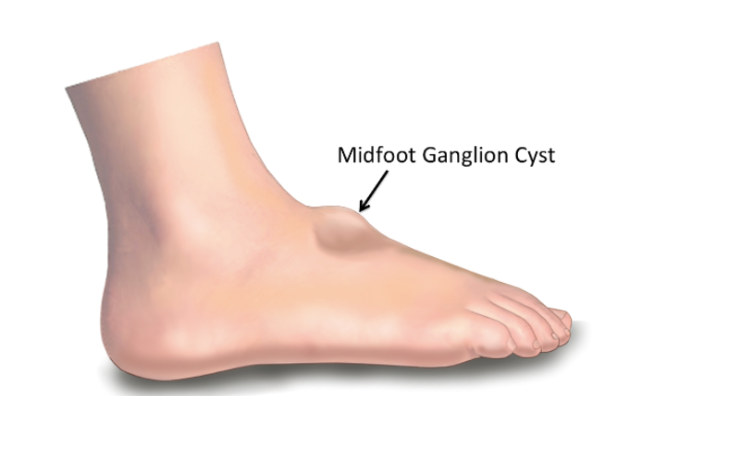
Jump to section
Noticing a distinct, unexpected and in many cases asymptomatic lump on your foot or ankle can be quite concerning. A common cause of these masses is a ganglion cyst, which are benign (meaning that they are non-cancerous) and have various approaches to treatment that we can help you with.
Ganglion cysts are smooth, fluid-filled masses that develop beneath the skin on the feet, as well as the hands and wrists. Ganglion cysts
can either be painful or asymptomatic. The majority of these cysts we see are the latter. Ganglion cysts can also vary greatly in size, and
tend to develop near the joints, often protruding at the top or bottom of the foot or ankle.
While the term ‘ganglion’ may initially leave the impression that this cyst is serious or potentially harmful, the cyst itself
has nothing to do with the neural ‘ganglions’ you may have heard of, which describe a group of neural cells in our nervous
system. Instead, their name traces back to the greek term for ‘knot’, or ‘swelling beneath the skin’.
The cause of a ganglion cyst currently remains unknown. It is thought that it may be related to injury, irritation or stress to the foot or ankle, which may result in synovial fluid leaking from a joint and collecting in a sac beneath the skin.
 Ganglion
cysts present as noticeable, round lumps that feel jelly-like when pressed upon. Their average size is just below 3cm. The location of the
cyst usually determines whether you feel any pain - while they are not painful on their own, if their location means that they push
against ligaments, tendons or other structures, then you may experience pain or tenderness. If the cyst pushes against a nerve, you may
experience tingling, pins and needles, burning or numbness in the area. Tight shoes may also press against the cyst and cause irritation
or tenderness.
Ganglion
cysts present as noticeable, round lumps that feel jelly-like when pressed upon. Their average size is just below 3cm. The location of the
cyst usually determines whether you feel any pain - while they are not painful on their own, if their location means that they push
against ligaments, tendons or other structures, then you may experience pain or tenderness. If the cyst pushes against a nerve, you may
experience tingling, pins and needles, burning or numbness in the area. Tight shoes may also press against the cyst and cause irritation
or tenderness.
Ganglion cysts are also unpredictable - appearing spontaneously, increasing in size without a distinct cause, and disappearing and reappearing from time to time.
Due to their unpredictable nature, it can be difficult to make a ganglion cyst go away without having it either surgically drained or removed. With this said, ganglion cysts do not always require treatment, particularly if they’re not producing any symptoms or interfering with your daily life. To find out all of your options and decide what is best for you, book in for a consultation with your podiatrist. They’ll also confirm that the lump is a cyst, and is not being caused by anything else.
Options for ganglion cyst treatment include:
Your podiatrist will discuss this with you in relation to your symptoms, how the cyst is interfering with your daily life, and your goals. Aspirating (draining) the cyst has notable benefits, such as being much less invasive, being able to be performed inside the clinic without “going for surgery”, and having a very fast recovery time. You’ll notice an immediate improvement in your symptoms, since removing the fluid eases the pressure on the area. Studies show that ganglion aspiration has a very high satisfaction rate among patients.
Does it hurt to get a ganglion cyst drained?
As we use local anaesthetic to numb the area, there is no further pain.
How long does it take to recover from ganglion cyst drainage?
Recovery is very quick - you are free to go home after your procedure, and any discomfort you may experience after that is simply related to the insertion of a needle.
Joint mobility after treatment
As the volume of the cyst can interfere with joint mobility, once the cyst is drained, you should experience improved joint mobility.
Can a ganglion cyst come back?
Yes, the nature of a ganglion cyst means that they can reappear at any time for no specific reason, regardless of your choice of treatment.
References
https://www.ncbi.nlm.nih.gov/pmc/articles/PMC5721324/
https://www.ncbi.nlm.nih.gov/pmc/articles/PMC4045351/
https://www.ncbi.nlm.nih.gov/pmc/articles/PMC4364146/
| Monday | 7:40am - 6:00pm |
| Tuesday | 7:40am - 6:00pm |
| Wednesday | 7:40am - 6:00pm |
| Thursday |
7:40am - 6:00pm |
| Friday | TEMP CLOSED |
| Saturday | CLOSED |
| Sunday | CLOSED |
Ground Floor, 344 Queen Street,
Brisbane City QLD 4000
| Monday | 7:40am - 6:00pm |
| Tuesday | 7:40am - 6:00pm |
| Wednesday | 7:40am - 6:00pm |
| Thursday |
7:40am - 6:30pm |
| Friday | 7:40am - 5:00pm |
| Saturday | 7:40am - 4:30pm |
| Sunday | CLOSED |
Newmarket Village, 114/400 Newmarket Rd, Newmarket QLD 4051